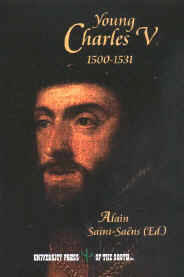|

Presentation by
Dr. Linda L. Carroll
(Tulane University)
author of the article,
"Venetian Attitudes Toward the Young Charles:
Carnival, Commerce, and Compagnie
della Calza."
|
Linda L. Carroll,
Professor of Italian at Tulane University, received the B.A. from Princeton University in 1971 and the M.A. and Ph. D. from Harvard
University in 1972 and 1977. She is the author of Language and Dialect
in Ruzante and Goldoni (Ravenna, 1981), Angelo Beolco (Il Ruzante)
(Boston, 1990; CD-ROM edition 1997), and numerous articles on popular
culture in the Renaissance appearing in scholarly journals and conference
proceedings.
Linda L. Carroll is the translator for the Sanudo Project under the
direction of Patricia H. Labalme.
She has been awarded grants from the
Fulbright Commission,
the National Endowment for the Humanities,
the
American Philosophical Society,
and the Delmas Foundation.
Linda L. Carroll
was the recipient of
USG John Stibbs Award
for Outstanding Faculty Member in 2007.
Linda L. Carroll
is the recipient of the Tulane University 2008
Weiss Presidential Fellowship Award
for Undergraduate Teaching.
|
Why Did You Do the Research on your Subject?
I undertook research on this subject because in reading Sanudo's Diarii
for material on the relationship between theater and political life in
early sixteenth century Venice I began to notice information indicating
that the usual view of Venice as being strongly pro-French in this period
was inadequate. The more I read the clearer it became that an appreciable
segment of the patriciate in the post-Cambrai period was willing to act in
ways favoring relations with the empire rather than France. The chronology
of this emerging willingness demonstrated that Charles's extensive dominion
exercised a decisive influence: when the Venetians resumed maritime trade
after the eight years of the Cambrai Wars, they faced a situation in which
Charles controlled or influenced not only the final destination of the
western galleys (Flanders) but much of the litoral along which they
travelled and with whose inhabitants they traded (southern Italy, portions
of the north African coast, and the Spanish coast). Given the importance
of this route to the gold, spice, and wool trades, many investing in them
felt that it was necessary to find a
modus vivendi with Charles. By
tracking the families involved in western trade and the members of the
maritime commission (the savi ai ordeni), I was able to establish that
families with those investments had a higher probability of favoring the
empire, even ones that had traditionally strongly supported France. Using
recent studies of Charles's preferred iconography, I was also able to link
Ruzante's 1520 performance with the Immortali
to a pro-imperial stance.
Further research into the membership of the
Immortali showed that those
members of that Compagnia della Calza supporting Charles tended to be
families with large land investments in the terraferma state or
ecclesiastical ambitions. Given the likelihood that Charles would make war
on Venice and exert a strong influence over the Church, these families
apparently believed that it was wise to be on his good side.
What is
Your Impression of Charles V and Venice?
The relationship between Charles and Venice in the years following the wars
of Cambrai was complicated by a number of factors. Principal among them
was the fact that the mainland dominion that Venice had conquered in the
fifteenth century had theretofore largely been under imperial rule, and the
Venetians' great concern about accusations of disloyalty to France, a
sensitivity natural following a war characterized by a dizzying succession
of alliances. For these reasons, although Sanudo records a few bold
statements such as "Charles will be the greatest king in the world," many
Venetians approached him through covert or even clandestine routes. One
typical strategy was to host a young visitor to Venice known to be well
received in the imperial court. For the most ardently pro-French, however,
even this strategy presented dangers to one's reputation and other
affiliations. Thus the young Prince of Sanseverino, a darling of Charles's
court on route to assuming his newly-inherited lands in southern Italy,
attended in disguise a dinner hosted by Alvise Pisani, so pure in his
devotion to France that he would later die supporting their ill-fated siege
of Naples but so heavily invested in the western galleys on behalf of the
young men of his patriline and so desirous of Church offices for his son
Cardinal Francesco that he found a connection to Charles imperative.
Sanudo, himself a Francophile, did not describe the dinner and only
recorded the Prince's attendance at it several days later. As noted above,
a further strategy, often employed in festivities and creative works, was
the choice of icons that alluded to but did not directly proclaim an
affiliation with the empire.
What is
Your Impression of the Book, Young Charles V,
1500-1531?
Young Charles V is a superb addition to the scholarly literature
on this
key figure of the Renaissance. By exploring a relatively little studied
and yet formative period of Charles's life from a broad range of
perspectives, it vastly enriches our understanding of a complex and
powerful player on the world stage.

|




